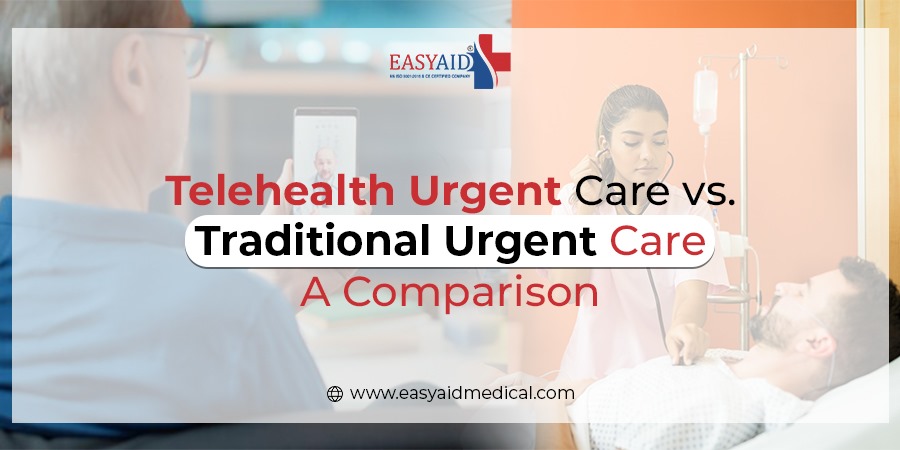Telehealth care is gaining popularity rapidly because of its convenience and ease of accessibility. This blog compares telehealthurgent care with traditional urgent care, highlighting their advantages and disadvantages. It’s going to be a great read that you must stick to till the end!
What is Telehealth Urgent Care?
This is healthcare delivery done at a distance using information and communication technology. With a telehealth urgent care appointment, patients can consult and be treated without physically visiting the doctor’s clinic. This enables individuals, whose mobility might be a problem, or those living in remote locations, to access urgent care services.
Benefits of Urgent Care Telehealth Appointment
There is no better option than telehealth urgent care. This allows patients to schedule appointments from wherever they are and hence no waiting for hours in a congested waiting room. Furthermore, persons residing in distant places would have an opportunity to seek treatment without having to undergo long-distance journeys.
An urgent care telehealth appointment can be more cost-effective compared to a traditional one. Telehealth appointments prevent patients from incurring transportation costs and lost wages from the absence of work. Moreover, many telehealth services provide lower consultation costs than outpatient visits.
Time-saving is achieved for patients and healthcare providers in telehealth urgent care appointments. This is because patients no longer need to go for long distances to clinics and wait for their turn for consultations. For healthcare providers, they visit their clients at their homes or workplaces thus taking less time than in a clinic visit. This makes efficiency for both sides and decreases overall stress on the health care system.
Limitations of Telehealth Urgent Care
Physical examination is amongst the most prominent limitations of a telehealth urgent care appointment. Healthcare providers can assess the symptoms and give medical advice but some conditions would require a physical examination that cannot be done virtually.
Telehealth is an emergency care highly dependent on a technological platform. However, any technical issue may compromise patient care. Low internet connections or problems with the videoconferencing software may interrupt the consultation procedure and adversely affect the precision of findings.
Telehealth emergency or urgent care appointments could be limited in their ability to prescribe medications in some cases. Some of these controlled substances or prescription drugs that require physical examination cannot be done through a telehealth appointment setting. This could mean that some patients will take a while to access particular medications that they need on the spot.
What is Traditional Urgent Care?
Urgent care is a type of healthcare facility that offers prompt medical care for non-emergency health conditions and situations. Generally, these centers have doctors, nurses, and other health service providers who respond to different forms of emergency medical issues. Traditional urgent care is usually equipped with a simple x-ray system and laboratory tests which provide minimal procedures like suturing. They offer healthcare service at a convenience, which is not limited to business hours only.
These patients will be attended to immediately when they come in unannounced with problems ranging from minor injuries, illnesses, infections, and common ailments. Urgent care centers have traditionally been established as an alternative to primary care and emergency department visits. These are more affordable and convenient for those needing prompt medical service.
Traditional Urgent Care Advantages
Traditional urgent care centers have an advantage in that they provide for the evaluation of a client’s condition through a physical examination. This works well, especially for patients with complicated or critical cases requiring a hands-on approach.
Urgent care centers have many types of diagnostic equipment, including X-ray machines and laboratory tools. With these tools, healthcare providers can promptly diagnose different conditions for the provision of comprehensive care.
In a conventional urgent care center, patients are likely to find a chemist on the site where they can get their prescribed drugs immediately. This is especially significant for individuals whose problem demands urgent help or therapy.
Traditional Urgent Care Limitations
There are a couple of shortcomings associated with traditional urgent care that may limit patient satisfaction in total.
A common problem that exists in these facilities includes lengthy wait times. The patients find themselves having to spend hours in crowded waiting rooms, which is frustrating and uncomfortable. This might have consequences for people who would expect to get help quickly.
- Cost
Urgent care telehealth appointment centers remain relatively expensive compared to the emergency rooms and they become extremely costly for the uninsured. Patients could also incur additional expenses such as surprise bills or extra expenses on some medical products or procedures.
There are other urgent care centers in hospitals that normally operate on a daily basis and are only open between normal working hours. Thus, patients experiencing emergencies on evenings, weekends, or holidays will be hard-pressed to access medical care. This could force them to wait or resort to expensive alternatives such as emergency rooms.
Continuous quality care is not ensured. Patients usually receive treatment from different healthcare providers when they attend urgent care in traditional healthcare setups. Familiarity and continuity are often absent. This reduces the quality of care when providers may not have information on a patient’s medical history including other issues or ongoing treatments.
Most of the traditional urgent care centers are poorly equipped with diagnostic capabilities. They may not have the necessary equipment and other resources that are required in more complex medical conditions and emergencies. This may lead to delayed diagnoses or inappropriate treatments that could undermine patient outcomes.
Also Read – Saudi Arabia’s Dietary Supplements Market Analysis
An urgent care telehealth appointment and traditional urgent care have advantages and disadvantages respectively. Telehealth urgent care is convenient, easily accessed, and cheaper, but it may not be able to do a thorough physical examination and prescribe some drugs. However, conventional urgent care offers physical examination, extensive diagnostic equipment, and immediate availability of drugs. Finally, one will have to choose between the two alternatives depending on his or her unique requirements.

